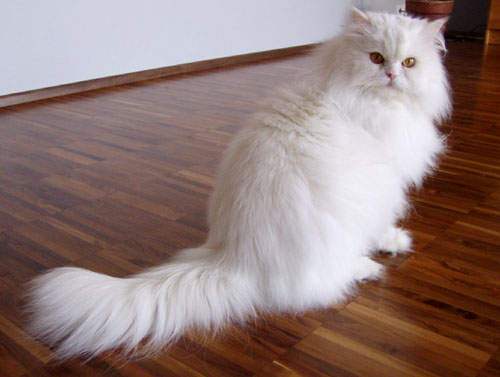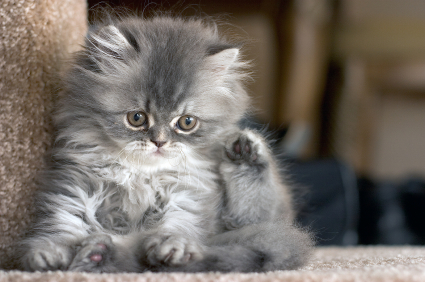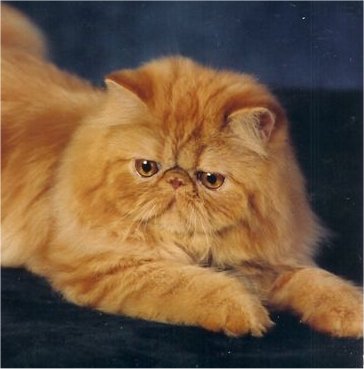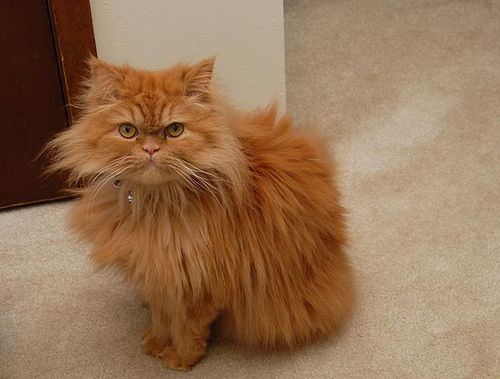



|
Persian Description
There are seven Persian divisions: solid, silver/gold, shaded/smoke, tabby, particolor, bicolor, and himalayan, with 86 colors and color combinations spread between them. Unlike other breeds such as the Ragamuffin, where any combination and style of color with spotted pads and noses may be acceptable, Persians are kept to a very high standard with requirements ranging from color combinations in the coat to nose and pad and eye color. The body of the Persian is meant to appear heavily boned but rounded, the cat should appear well-rounded and sweet. Legs should be stocky with large firms paws. The tail should be short but proportional and without a curve. Outside of color, the coat should be long and luxurious, standing out from the body and coming to a form a frilly collar between the front legs. There should be long tufts of fur coming from the ears and between the toes. The coat should be thick, rounding the shape of the cat and look healthy or "full of life". The head of the Persian should be large and round, with a smooth skull, stubbed nose and full cheeks. Ears should be small and round tipped, tilted forward and low on the head. Eye color should be brilliant, with eyes level and spaced apart.
Persian Temperament
The Persian, though not a good cat for a multi-pet or hectic household, is very loving. The breed is not given to fits of hysterical play such as shredding of furniture or climbing of curtains. This has, at times, been misconstrued as stupidity. Quite to the contrary, Persians are very intelligent and loving, having been described as dog-like in their devotion. They have a quiet and melodious voice which is non-abrasive and rarely used.
Persian Care
Number one in popularity, it is important that potential owners realize that the Persian is a high maintenance cat. The coat is prone to matting that can cause hair balls. Daily brushing is absolutely necessary and weekly baths are encouraged; bi-weekly baths are absolutely necessary. Baths should only be given after a full brushing and nail trim, and it is recommended that owners begin bathing their kittens early. Certain coat types have special brushing and grooming needs and it is important to learn as much about the grooming needs of your cats' coat when you purchase a Persian. As with anything that is popular, the desire to cut corners and mass produce does not always mean a breeder will spend the time necessary to produce a quality cat. This decline in quality, however, is of predominant concern to the breeders and not, necessarily, the cat owner. If the breeder is reputable, they will have had their kittens, of any category or class, examined by a licensed Veterinarian and be selling a kitten free of any hereditary conditions. Persians are prone to watering eyes and a non-showing animal should have the hair of the hindquarters trimmed to keep the accumulation of feces from occurring. Persians are also susceptible to a hereditary condition called Progressive retinal atrophy (PRA) which causes blindness.
Persian History
There is an overwhelming interest in the most popular and long-standing breed of cat: Persians. Their early history is quite a mystery. Mentioned in hieroglyphs as early as 1684 BC, Persians have been the breed to give cats a name. The breed was first recorded as being seen in Europe in the 1500's on caravans from Persia. Pietro Della Valle is credited with bringing the cat into Western Europe; the breed is mentioned and described in detail in his manuscripts of his travels.
The breed was introduced to America in the 1800's and quickly pushed all other breeds out of the spotlight. In Britain, its popularity skyrocketed in the early 1900's, possibly because Queen Victoria owned two. It is interesting to note that the British Governing Council of the Cat Fancy considers each of the colors to be a specific breed while in North America all colors fall under the single breed.
|